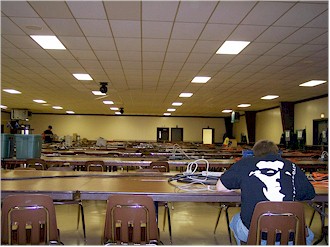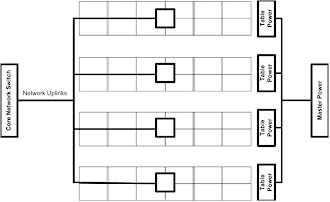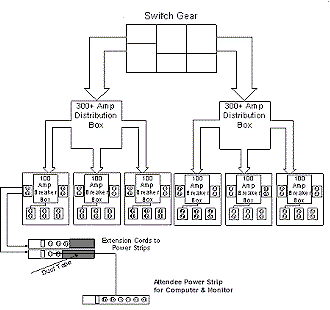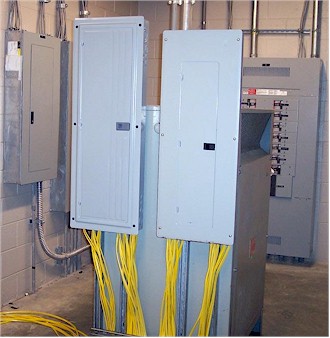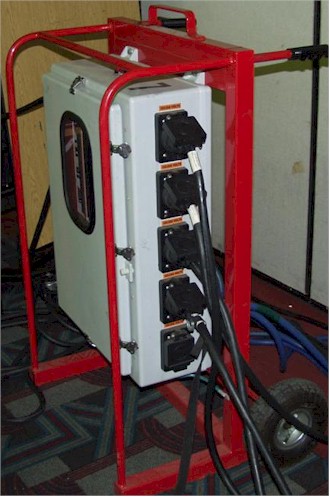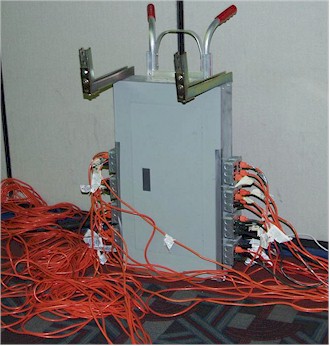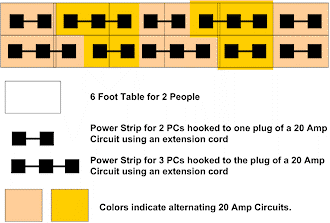Introduction
So you’ve been going to LAN parties for awhile and know that they can be a fun and exciting experience for you as a gamer. But somehow you’ve gotten the idea into your head that it would be even more fun to host a party yourself. Do you just set up some tables, plug in some power strips, buy a switch big enough to handle the number of players you’re planning on and send out the invites?
While in some cases it can be as easy as that, hosting successful large LAN parties requires specialized knowledge, good organization skills and attention to details. In this series of articles I’ll be giving you some of that knowledge you should have before you put on your first Party. But first you might want to know who the heck I am and why you might want to listen to me.
I have been attending LAN parties since late 1998 and have watched them grow in popularity and complexity. As a newbie myself, I started attending LANWAR, a party based out of Louisville, KY, which currently holds a party four times a year with around 550 players in attendance.
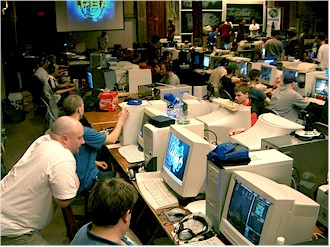
Figure 1: LAN Party in Progress
As the staff struggled to keep the event running smoothly, it was apparent after a number of events that one aspect of the party consistently needed improvement – its network. I suppose being a glutton for punishment (and excited about the challenge) I decided to step up to the plate and volunteer my services to LANWAR.
Around early 2000, I became the lead net-head for that event and quickly began implementing a solid infrastructure. Through experience at that event, I learned a great deal about setting up a solid gaming network and shortly after, started a LAN rental business.
Garage LAN or Mega LAN?
On the surface, the differences between your average garage LAN and a Mega-LAN are not apparent. But the truth is that behind the scenes they are very different. The first obvious difference is the head count. At your average home LAN party, you’re probably looking at around twelve people in attendance, although I’ve seen upwards of 30 people! Even that rather large home LAN attendance, however, pales in comparison to the hundreds and sometimes thousands of people in attendance at a Mega LAN.
Another major difference is that a Mega LAN typically is more formally organized, including an actual agenda with planned tournaments. Many large parties also have food and drink available for sale while garage LANs may purchase shared food from contributions to a pot.
Last, but not least, the network infrastructure is vastly different for garage and Mega parties. Hundreds of users place an exponential load on a network that won’t be handled very well by just plugging everyone into cascaded 10/100 switches. I’ll go into more details regarding LAN design in my next article, “Building and Maintaining the LAN”.
I have summarized the basic differences between small and large LAN parties in Table 1.
| Garage LAN | Mega LAN | |
|---|---|---|
| Attendance | 10-25 people | 25-1000 or more people |
| Food | Honor system – shared food bought using pooled money | Concession style – Items sold separately at fixed prices |
| Formality | None | Set agenda with planned tournaments |
| Strangers | Lots of people you know | People you know and a whole lot you don’t |
| Network Infrastructure | Basic | Intermediate to Advanced |
| Staff Members | 1-2 | 3-?? |
| Table 1: Basic differences between small and large LAN parties | ||
Got Cash?
Setting up a garage LAN might set you back between nothing at all and $150 depending on equipment you may already have. But getting the kind of equipment you need to properly run a Mega party could run into the tens of thousands of dollars! Some things can be rented, others can be bought, but in the end a balance sheet will be required to run these huge events – there’s no way around it. Table 2 has some numbers to clue you to the kind of money you’ll need to get started.
|
Party Size |
Small LAN |
Medium LAN |
Big LAN |
|---|---|---|---|
|
Venue |
Home – $50 police ticket if called in by the neighbors for being noisy |
Small Hall – $250-$750 depending on quality, timing and location |
Big Hall – $1,750-$3,000 depending on quality, timing and location |
|
Tables |
Around the House |
Rented – 2 per 6ft @ $6 ea = $100 |
Rented – 2 per 6ft @ $5 ea = $1,250 |
|
Network Gear |
Basic 24-port 10/100 switch = $90 |
Basic 8-port Gig & 3 24-port 10/100 switches w/Gig = $480 |
Managed 24-port Gig & 21 24-port 10/100 switches w/Gig = $4,520 |
|
Network Cabling |
Not Needed |
$45 Premade |
Around 4 boxes of Category 5e cable, Crimpers and Jacks (~$300 DIY) |
|
Server Connectivity |
Not Needed |
Optional $120 gigabit uplink switch |
2 Managed 24-port 10/100 w/Gig = $700 |
|
Core Servers |
Not Needed |
Not Needed |
$500 Server |
|
Wireless Access |
SOHO WiFi Firewall = $100 |
SOHO WiFi Firewall = $100 |
High Capacity Enterprise WAP = ~$300 |
|
Internet Firewall |
Without WiFi = $50 |
Without WiFi = $50 |
High Capacity Enterprise Firewall = ~$300 DIY / $750 Prebuilt |
|
One-Time Costs |
$140-$190 |
$575-$745 |
$6,620-$7,070 |
|
Per Event Costs |
N/A |
$350-$850 |
$3,000-$4,250 |
| Table 2: Differences between small and large LAN parties | |||
As you can see, the big guys are either digging deep into their own pockets, have a major investor, or perhaps have corporate sponsors that are furnishing equipment or cash in exchange for advertising and / or marketing at the events.
If you’re still interested after seeing those dollar figures, read on and we’ll get you going!
Choosing the Venue
Perhaps one of the most difficult tasks when getting a big LAN party started is finding the right facility and location. So many factors come into play that your head may be spinning after a while! But ultimately this is an important aspect of the party that you’ll have to stick with from event to event. So be careful who you partner with, and make sure you are comfortable dealing with the people who own the facility.
Here are some key considerations when looking at venues:
Location, Location, Location – Convenience for your prospective attendees is often an issue, so try to locate a venue which is central to most of your target audience. When the party gets bigger and more well known, you will probably have people coming from all over the country. But to get started, a convenient location will be very helpful.
Space – If there’s not enough space to seat the number of people you plan to have attending, that pretty much takes a site out of the running. Of course, if the venue turns out to be the largest you can find, then maybe you might consider compromising on the number of people in attendance.
Power Needs & Flexibility – I’ve seen so many halls that have gobs of space available and nowhere near enough power available to run the hundreds of computers that will be plugging in. If enough power circuits are not already available within the building and you’re not able to locate another comparable venue, ask if the have additional capacity on their incoming “switch gear”. With the proper hookups, you can contract an outside power rental company to bring in proper power equipment and tap directly into the building power to give you the extra capacity you need.
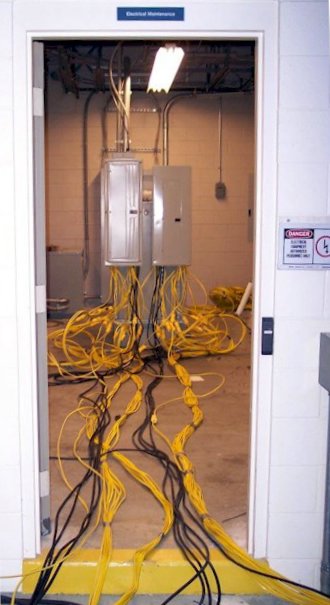
Figure 2: Sometimes you need to go direct to the Source
Food & Beverage Contracts – $2.50 for a Coke? Ouch! Yeah, sometimes venues have exclusive contracts with vendors that provide food and beverage for all events in their buildings. But LAN attendees are usually going to lots of events and pinch every penny, so $2.50 for a cola isn’t going to cut it at anything but the largest parties. If you want to provide more reasonably-priced food and drink for your attendees, you might ask the vendor if they have a “buy out” price. This would allow you to run your own concessions at a much lower profit margin. Sometimes you will just have to move along if you think this will cause a loss of interest in your event.
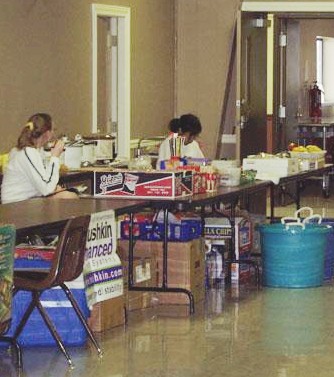
Figure 3: Concession stand ready for business
Overnight Stays – LAN players are night owls, but you will find that a lot of venues will not allow people to stay inside the hall overnight for security reasons. If the venue is your only option, you might consider paying an additional (usually pretty reasonable) fee for security to be on-site during the night. Be sure to have this arranged ahead of time before your event, because they have to locate a guard who is willing to work overtime for you!
Cost – Of course cost will come into play as well, but take this one up with your accountant and find something that you won’t lose money on.
If you’re running a tiny party, you don’t have to go any further than your garage. But be careful, power is an important thing even for a garage party!
Setting Up for Success
Setting up a small LAN party is pretty simple, and you can be very flexible given the reduced amount of power and network that you will need to provide. But organization becomes paramount when getting your medium-sized LAN party set up with tables, network switches and power distribution.
Tables
Tables are usually arranged in rows of pairs of tables set back-to-back lengthwise, with usually twelve tables per double row. I personally prefer 6 foot tables with two people per table. I’ve been to parties where the organizers tried to optimize space by using 8 foot tables with three people per table. And while this is possible, it’s nowhere near as comfortable. Two people per 6 foot table gives each person about 3 feet, while with three people at an 8 foot table, you’re only getting about 2.5 feet of elbow room.
Figure 4: Tables as far as the eye can see
(click image to enlarge)
Believe me, that extra half foot makes all the difference, especially when you get parked next to the guy who brought his HP Xeon workstation that looks like a military installation or the guy with the 2 foot wide mousepad who thinks he’s the CPL poster boy. If you can’t get 6 foot tables, 8 footers will do, but stay away from 10 foot tables because the weight of gear will cause them to sag.
Another reason for the 2 X 6 X 2 arrangement is that it matches nicely with the most common network gear that has 24 10/100 ports. It is not a good idea to go with 48 port switches due to the length of network cables attendees will need to bring in order to reach all the way to their designated table switch. So keep it to 24 peeps. If absolutely necessary to put more than 24 people in a single (double) row, just use a second 24-port switch instead of a 48.
Cabling
You will be laying down two different types of cabling – network and power. So try to feed each of these from opposite ends of the table if possible (Figure 5 ).
Figure 5: Separate your Power and Network feeds
(click image to enlarge)
This arrangement makes it convenient to locate a power problem without having to sort through network cables at the same time, and vice versa. It also helps prevent EMI / RFI interference on your network cabling, which could happen if they ran over and around high amperage rubber-covered power cords.
Another point to remember is that the network “core” or “server row” area should be placed as central to the room as possible and on the end of the tables where you intend to run the network cables from.
While I’m on the subject of cables – the last thing you need is a lawsuit because someone tripped and hurt themselves on one! So bring lots of duct tape and use it for securing cables down that people will be walking and / or carting over.
Be careful of the kind of tape you buy however, since some types are very tough to remove and may leave sticky residue and other kinds won’t stick very well at all. Experiment if possible with several kinds before buying a truckload of it! It’s also wise to consult with the venue to be sure that taping is okay. If it’s not, you may be stuck having to find floor mats to throw over the cables.
Other Points to Consider
It should be obvious, but the sign-up desk should be outside of the hall where the event is held, not inside the door. Once a person is inside, it’s hard to tell whether he or she has properly filled out all of the liability forms and paid their admission. And if you can’t collect the money, you won’t be throwing parties for long!
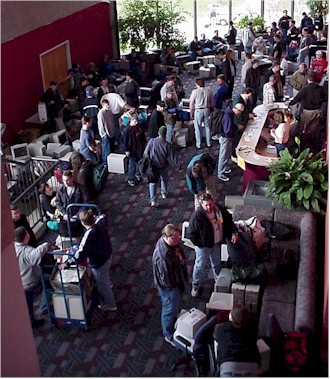
Figure 6: A busy Sign-Up Desk is a happy one
Other things I found that make the difference between an amateur and professionally-run LAN party:
- Print out individualized welcome sheets with the attendee’s handle or nickname on the sheet and place it at their reserved seat. This helps the person quickly locate their seat without having to hunt for a row and seat combo. In addition to the convenience, it’s also a nice personal touch.
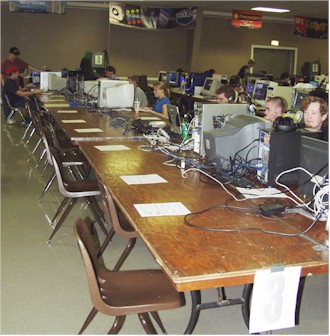
Figure 7: Welcome sheets await new players
-
A welcome bag with literature from your sponsors and / or a helpful FAQ sheet. The FAQ could include an event agenda, food prices, important places around the immediate area like hotels, and instructions on how to get their computer connected to their designated power strip and connected to the network. The FAQ should reduce the load on your help desk in addition to being convenient for the players. I’ve seen some events even include a CD-ROM including commonly forgotten game patches – especially for those games that there will be a tournament for.
Power – Garage Party
Although I’ve already touched on the subject of power, it is so important to the success of a large LAN party that I’m going to spend the rest of Part 1 on it. Power is just as important to a properly-run LAN party as the network or the tournaments themselves. While there are probably other ways, I’ll be sharing the formula which has worked well for me and the large LAN Parties that I’ve attended.
But before I describe how to handle the power for large events, let me first cover power for garage-sized parties. You’ll first need to figure the total power – actually amperage (A) – needed. Through experience, I’ve found that a rule of thumb of 4A per attendee works well. I have seen some events try to squeeze by at around 3A per system, but then have problems with systems randomly rebooting that are solved by moving players to other power circuits. Given that 500+ Watt power supplies on gaming machines are becoming more and more common, I highly recommend against trying to push the 4A figure lower. My experience is that 4A per attendee continues to work very well for all of the events I currently attend.
The next step is to determine the total power you have available. Most recently-built homes have 200A service, but older homes may have only 100A or smaller service. The only way to know for sure is to open the main breaker panel and look at the number on the handle of the large breaker usually located at the top of the box. If you have an older home with fuses, you may not have a breaker, but a fused disconnect instead. If this is your case, I recommend you leave it alone and assume you have only 100A service.
Now multiply the number of gamers you expect to have at your party by 4 to get the total amperage (A) you’ll need. As long as the number of players is 24 or fewer, you should be ok. But the larger the number of players, the more work you’ll need to do because now you have to identify enough separate circuits in your home to provide the power you need.
If you’re lucky, someone will have filled in the breaker identification label in the main box with titles like “master bedroom”, “garage”, “kitchen”, etc. But in most cases you’ll have to shut off a breaker at a time and using a lamp or radio figure out which which outlets are connected to it. As you’re shutting off breakers, make sure you note its amperage (printed on the handle), because your home may have mixtures of 15 and 20A circuits.
Once you’ve located your outlets and know the rating of the breakers that control them, you can plan on connecting five people to each 20A breaker circuit and three to each 15A (or maybe four if you’re feeling lucky). All you need to do now is mark the outlets accordingly and buy enough heavy-duty long extension cords to reach from those outlets to your garage, uh, venue. You’ll also need to buy some outlet strips and prepare them as I’ll describe later.
An important thing to note about home power distribution is that you typically have a smaller feed coming into the panel than the total of all the breakers. While this allows for larger loads in different home areas, residential power design assumes that all circuits won’t be loaded to capacity at the same time (if they were you would trip the main breaker). For example, a home might have a 100A feed and then ten 15A circuits and another ten 20A circuits totaling over 350A!
So if you have a 50A breaker dedicated to your hot tub and only have a 100 Amp service, either shut off the hot tub during your party, or avoid exceeding 50A on other circuits. You might also need to pull the plug on microwave ovens, air conditioners, hot water heaters, and electric dryers and ranges while your gamers are duking it out.
On to large-scale parties!
Power – Mega Party
Some events held at large conference halls or convention centers have relatively modest power requirements that can be handled by existing power hookups. But LAN parties require so much power that you will need to arrange for special power distribution. Whenever possible, I recommend you hire a contractor with the proper expertise to install the necessary power distribution equipment to run your event. This not only ensures that you’ll get properly sized and installed power, but also provides a good amount of insurance against liability in case something horribly wrong happens.
Convention halls may have on-site staff that can handle what you need, so be sure to ask. Companies that provide power will usually solicit the venues which, in turn, use a referral system. Most of these agreements aren’t exclusive though, so once you find a power service you like, they can probably hook you up wherever you go.
If the venue folks don’t have any suggestions, you’ll have to use your local phone book, search engines, etc. and do some research. Be sure to check with local electric supply houses, who will probably be able to hook you up with the people you need.
Ok. Now study the diagram in Figure 8 and I’ll explain top-down how everything works.
Figure 8: Power System for 150 players
(click image to enlarge)
Switch Gear
The Switch Gear is the facility power equipment that is usually locked in a room and is accessible only by a qualified electrician. If you are familiar with Ethernet networks, this is the power equivalent of a core network switch and is either where the power enters the building from the power company, or a sub-circuit distribution point off it.
For a medium or large facility, this equipment is almost always of a type called “three phase”, which allows for a great deal of flexibility in accommodating a variety of power requirements. Without switch gear, it becomes very difficult – if not impossible – to connect the necessary distribution boxes for a large event. You should check with your venue to ensure that the rated capacity of the switch gear that you’ll have access to is enough to handle your total power requirements. (I’ll be telling you how to figure that shortly.) For our example shown in Figure 8 , the switch gear is supplying two 100A 3-phase circuits.
Figure 9: Switch Gear room with directly-wired table distribution
(click image to enlarge)
Figure 9 shows a typical switch gear room, but with an unusual arrangement of having the table distribution panels right in it, with long extension cords running to the tables. Notice the big panel on the back wall, complete with hunky circuit breakers.
Power – Distribution Boxes
Again, using the Ethernet network metaphor, a distribution box (Figure 10 ) is a lot like an access switch you might put at the concentration layer of your network. This box connects by large rubber covered power cable to the switch gear and breaks down into various large capacity circuits which ultimately feed the table boxes.
Figure 10: Distribution box
(click image to enlarge)
You will need distribution capacity to match the amperage requirements of the table boxes in order to prevent circuit overloading since it is expected that all systems will be on all the time. In our example power system shown in Figure 8, each distribution box takes a 100A three-phase circuit from the switch gear and converts it into three 120V 100A circuits. Using a rule of thumb of 4A per attendee, each distribution box would be able to handle 75 gamers. Of course power needs of the LAN party staff and network core must be added into your total power budget.
Table Boxes
A table box connects to the distribution box and, ideally, is sized to handle the number of players in each table row. Since our preferred table double-row seating handles 24 players, table boxes running off 100 A feeds match this nicely with one 4A load to spare (24 players X 4A = 96A)!
Table boxes usually look like a breaker panel that you might have in your home with a series of duplex outlet boxes mounted along each side. Each duplex outlet is wired to its own 20A circuit with both outlets connected to the same circuit. In our sample power system in Figure 8, each table box has five 20A duplex outlets, which matches our table setup. Figure 11 shows a different table box that handles up to 80 players via 16 20A outlets – obviously sized to handle about three rows of tables.
Figure 11: Table box sized for 80 attendees
(click image to enlarge)
Power – At the Table
We now reach the power strips. Given our 20A circuit with 4A per player, there should only be five power outlets available for players to plug their own surge protectors into. Since inexpensive outlet strips are sized for 15A and overloaded extension cords can heat up and catch fire, you’ll want to use two extension cords and power strips per 20A circuit instead of a single cord and strip.
Typically, you will want to run heavy-duty 12-16 gauge extension cords from the outlets on the table box down to the table location for the systems the circuit will power. Don’t skimp on cheap extension cords! I’ve found that single outlet cords intended for outdoor use are rugged, properly sized and work well. Plan on buying at least some 50 foot (or longer) extensions, since your power is feeding from one end of the table and you’ll need about 36 feet of cord to reach the farthest table location.
Figure 12: Table power outlet plan
(click image to enlarge)
Figure 12 shows the power strip arrangement that I’ve found works well with my perferred 12 table / 24 player cluster. You can see that it uses two flavors of power strips – one with three outlets and the other with two. Note in Figure 12 that the three outlet and two outlet strips are alternated so that their nearest neighbor is always the other flavor (except for one position at the bottom right position).

Figure 13: Taped up and ready for action!
Don’t worry about finding outlet strips with these exact numbers of outlets, since Figure 13 shows my low-tech solution for making them. It’s important to not skip this step of blocking outlets since if there’s an open outlet, it will get something plugged into it! An overloaded cord can overheat and catch fire, so block those spare outlets!
A final note is that you can use less expensive power strips without circuit breakers and preferably without power switches (if there’s no switch it can’t be accidentally shut off). Surge protection is ok if you want to spring for it, since it might provide an extra level of protection in an overload situation.
Attendee Surge Protector
At the very end of the power distribution is each gamer’s personal power distribution. All attendees should supply his or her own power strip (preferably with surge protection) for their computer and monitor. This is very important since with my power distribution scheme only a single outlet is available for each attendee.
As you can see, building a power grid is definitely not a chore to be taken lightly, considering the amount of power you will be dealing with. I would go as far to say that you shouldn’t even consider attempting anything without the assistance of a certified electrician. All of the equipment listed above should be rented from a company specializing in large event setups, or built by an insured contractor.
But no matter what, if something goes wrong with the power setup at your event, liability waivers may get you out of small incidents where one or two people’s computers get fried. But gross negligence will place you in serious hot water!
Closing Thoughts
Now that you’ve got the power distribution designed and set up for your event, you might think that you’re done. But you can still run into problems if you don’t establish some rules of the road – or the outlet strip – to ensure a problem-free event.
Nobody wants to deal with rolling blackouts or the dude who keeps popping the breaker on your shared circuit. So here are a few power-related rules that should be mandatory at your event:
No UPSes – A UPS or Uninterruptible Power Supply is a big no-no at a LAN party. The reason is that not only does it consume power to run the attached computer and monitor, but it also consumes power to charge the battery. And on top of that, there is an additional power load over and above the equipment load – even if at full charge!
Don’t ask me specifically what does this, but I have tested it with numerous top-tier brands and they all have similar results. You will be tapping the limits of your power gear to start with and don’t need this additional load causing problems for others. As long as power is set up correctly to begin with, your attendees will have no problems and can live without battery backup for one weekend.
B.Y.O. Surge Protector – In the unlikely case of a power surge, it’s always good to be protected at as many levels as possible. So I recommend that you require each gamer to bring his or her own local power distribution. The term I use for this gear is surge protector, but what I mean is a power strip that includes a circuit breaker (and hopefully some built-in surge protection) – as opposed to a bare-bones outlet strip that has just a cord and multiple outlets.
Having each participant provide their own surge protector is absolutely necessary if you are implementing the suggested power distribution scheme I previously outlined, since there is only one outlet provided per person. The circuit breaker on a surge protector should also keep problems local to each user instead of affecting everyone on the same table box breaker. And any built-in surge protection will help protect the user from other gamers’ power problems.
No extra stuff – Many events are very strict about saying “only your computer and monitor” are allowed to be plugged into the Party’s power grid. While it may seem harsh, having a stated rule removes any doubt as to whether extra devices are officially allowed to be plugged in. I remember a large Party where I was part of the staff that had to have a rule “no refrigerators, box fans or microwaves allowed” because we had people bringing everything and plugging it in – it was pretty insane!
The truth of the matter is that some people have reasonable needs beyond a computer and monitor such as an external hard drive, or cell phone charger. These are obviously not very big power draws and are probably reasonable to plug in, so you may want to modify the “only computer and monitor” rule accordingly. Another idea is to have gamers state any power requests beyond the stated rules when they check in.
Conclusion
I hope you’ve learned something about how to organize a smooth-running LAN party and get it powered properly. Part 2 of this How To will focus on the workings of the LAN Party network itself. I’ll cover in depth types of Ethernet cabling and hardware, network design / topology, optimizing performance, and more!
Christopher (AlexKidd) Dickens and his partner Dave Wilson own and operate LANrental.com, a LAN rental business serving the Kentucky, Indiana, Ohio, Southern Illinois, Eastern Missouri, Northern Alabama and Northern Georgia area.

